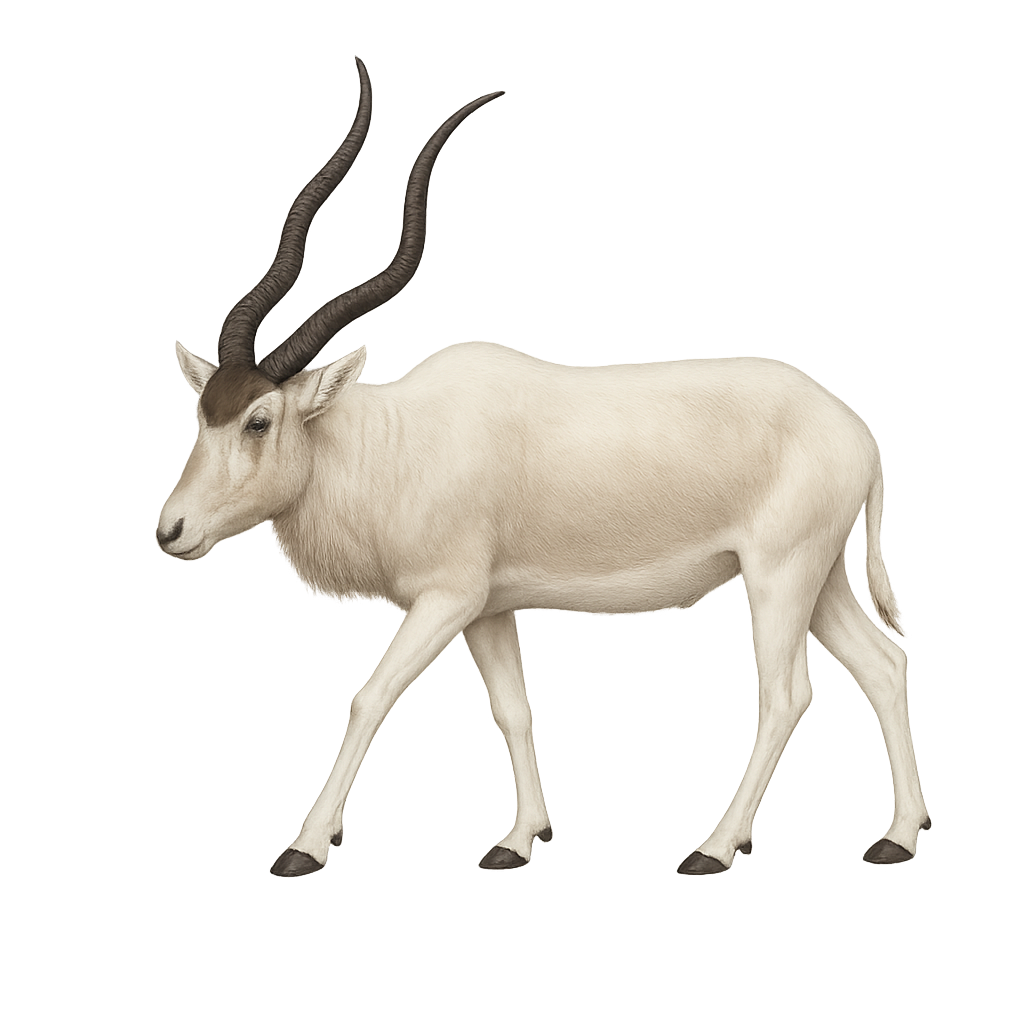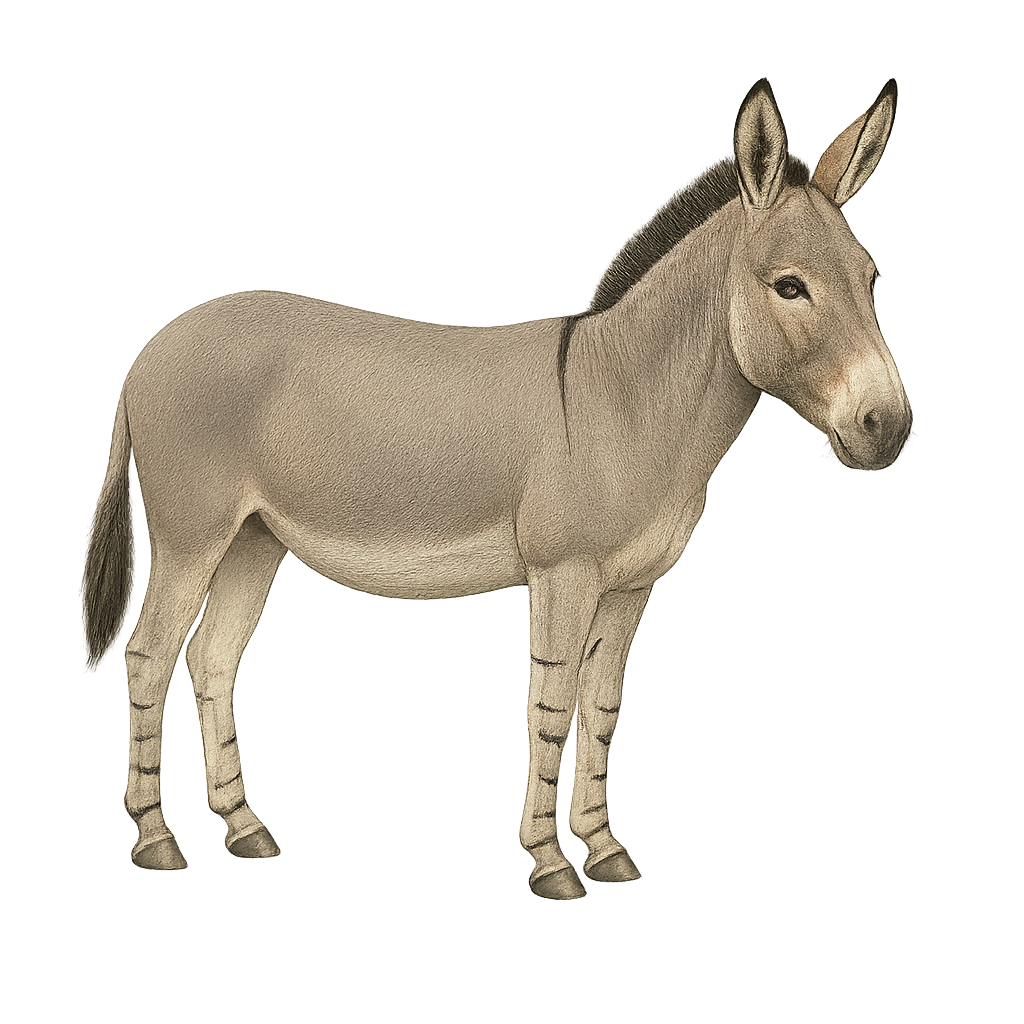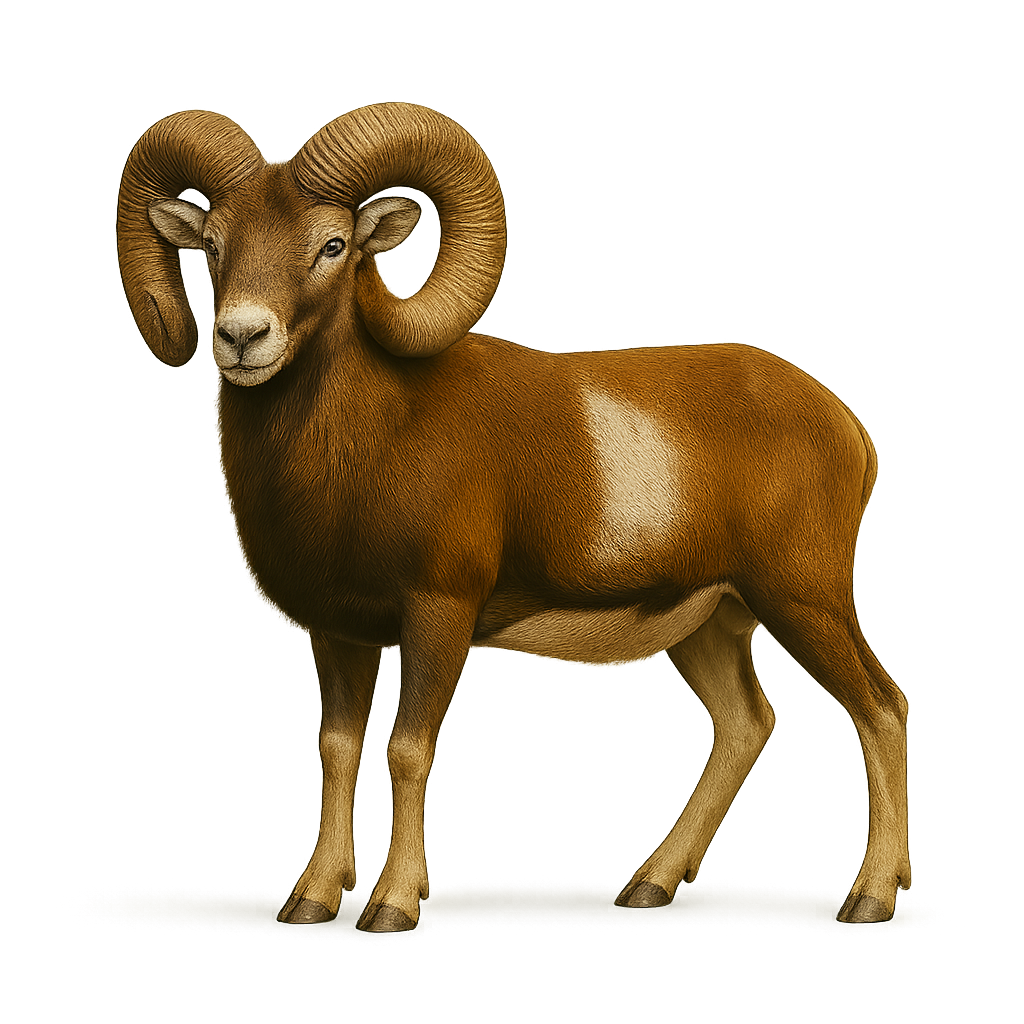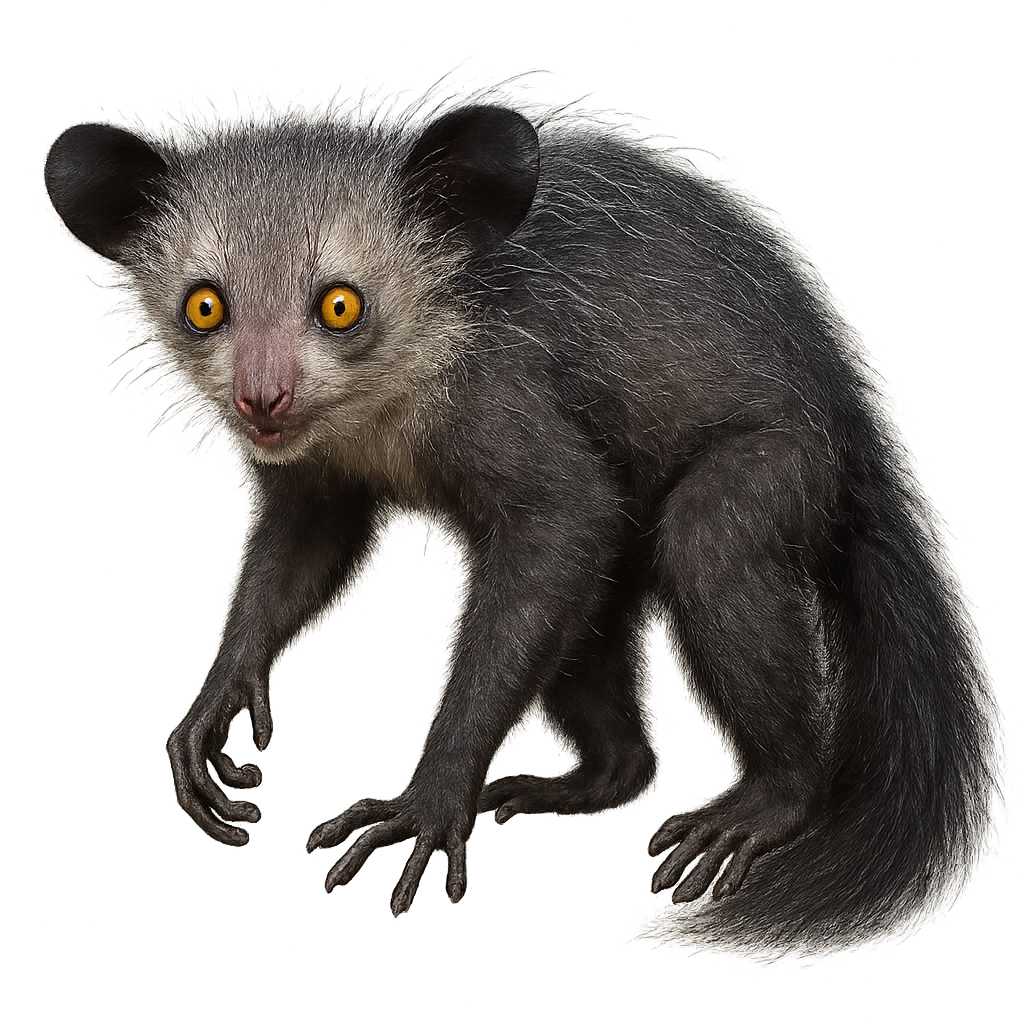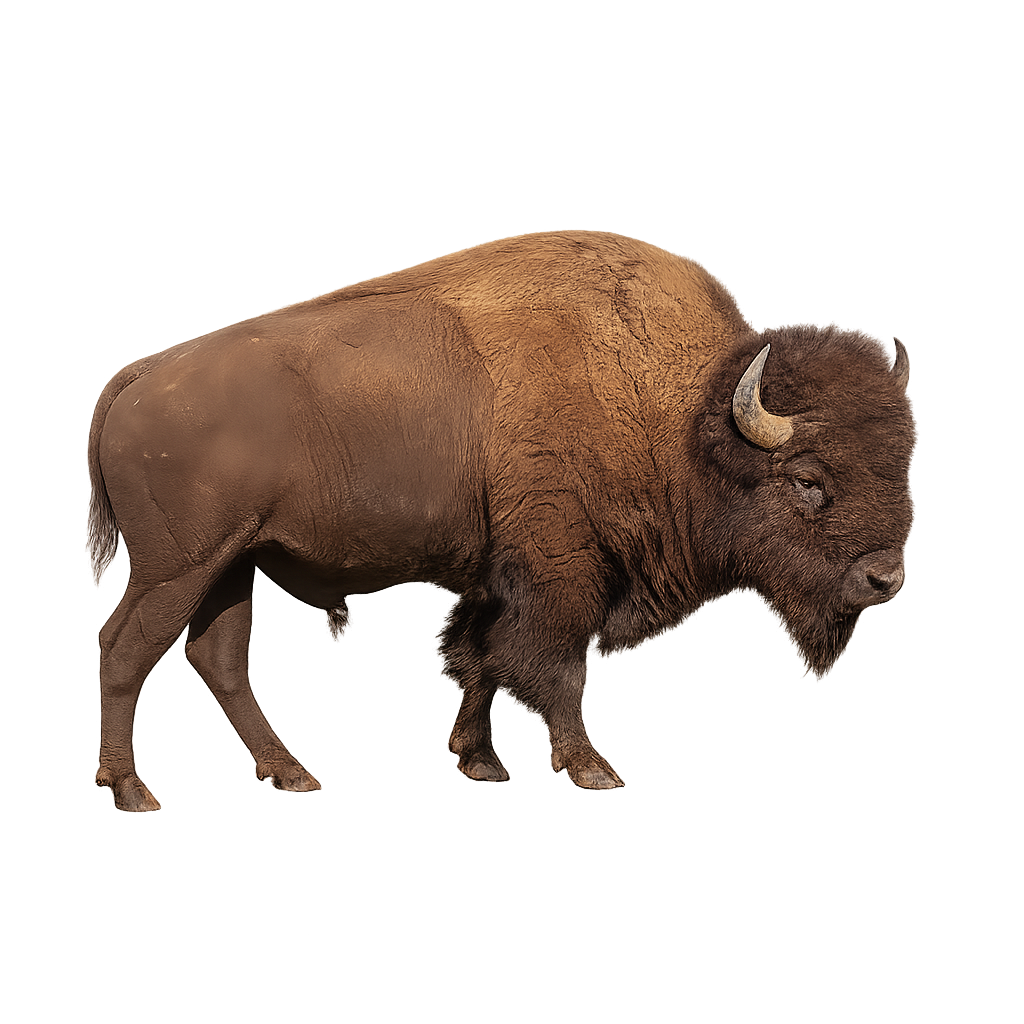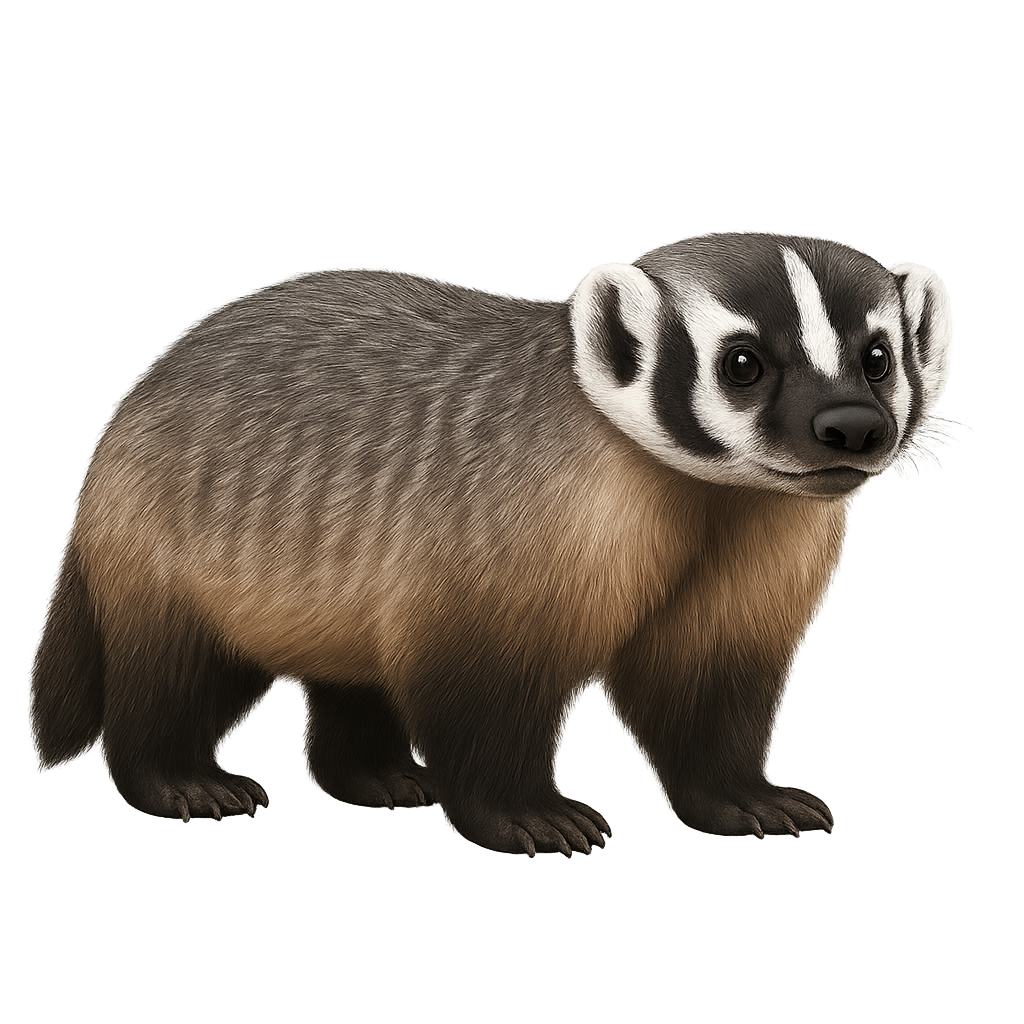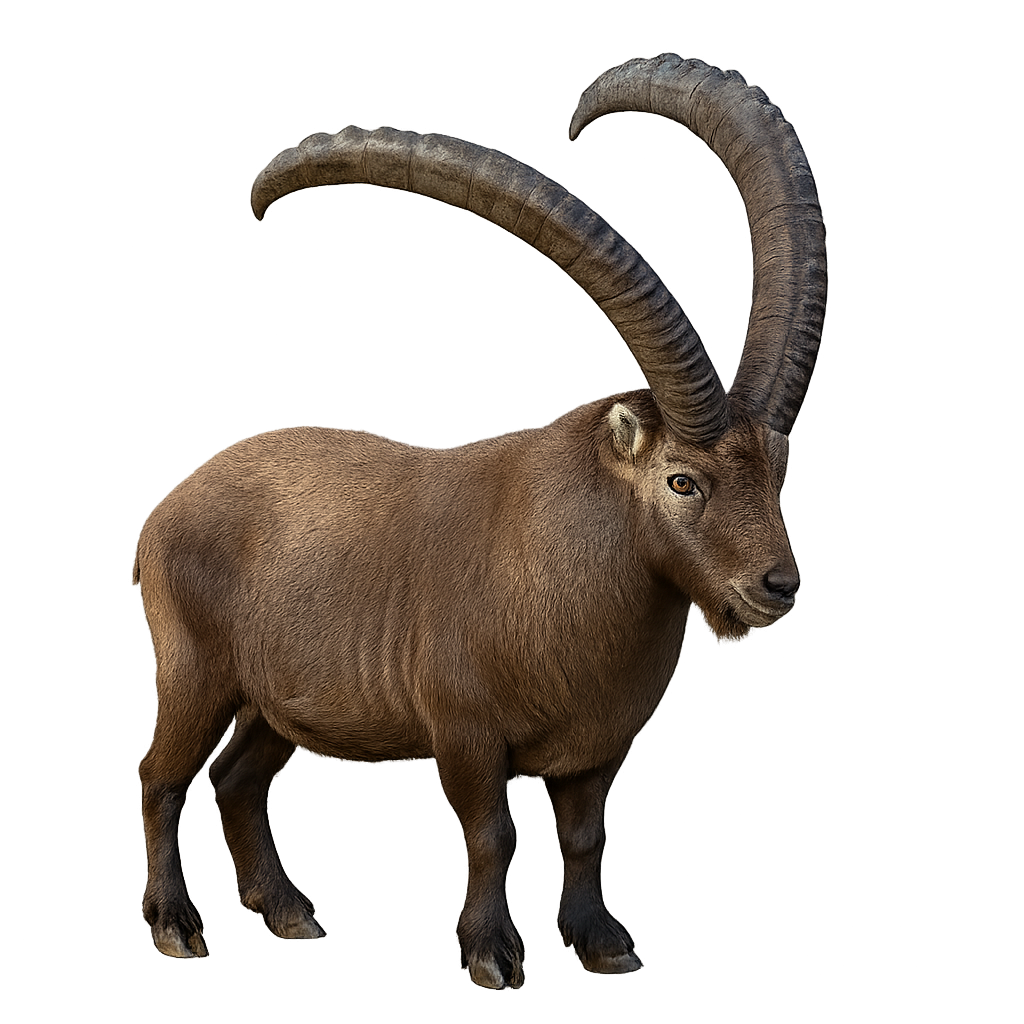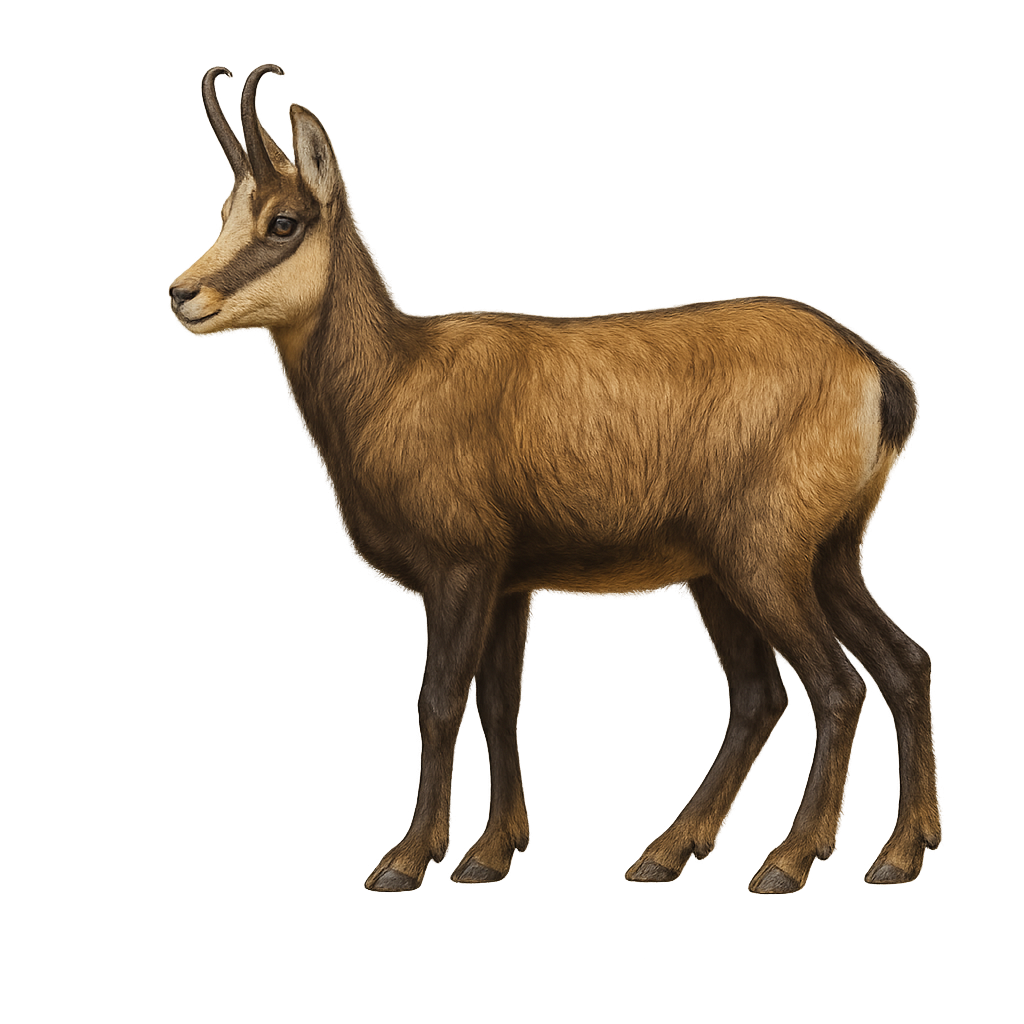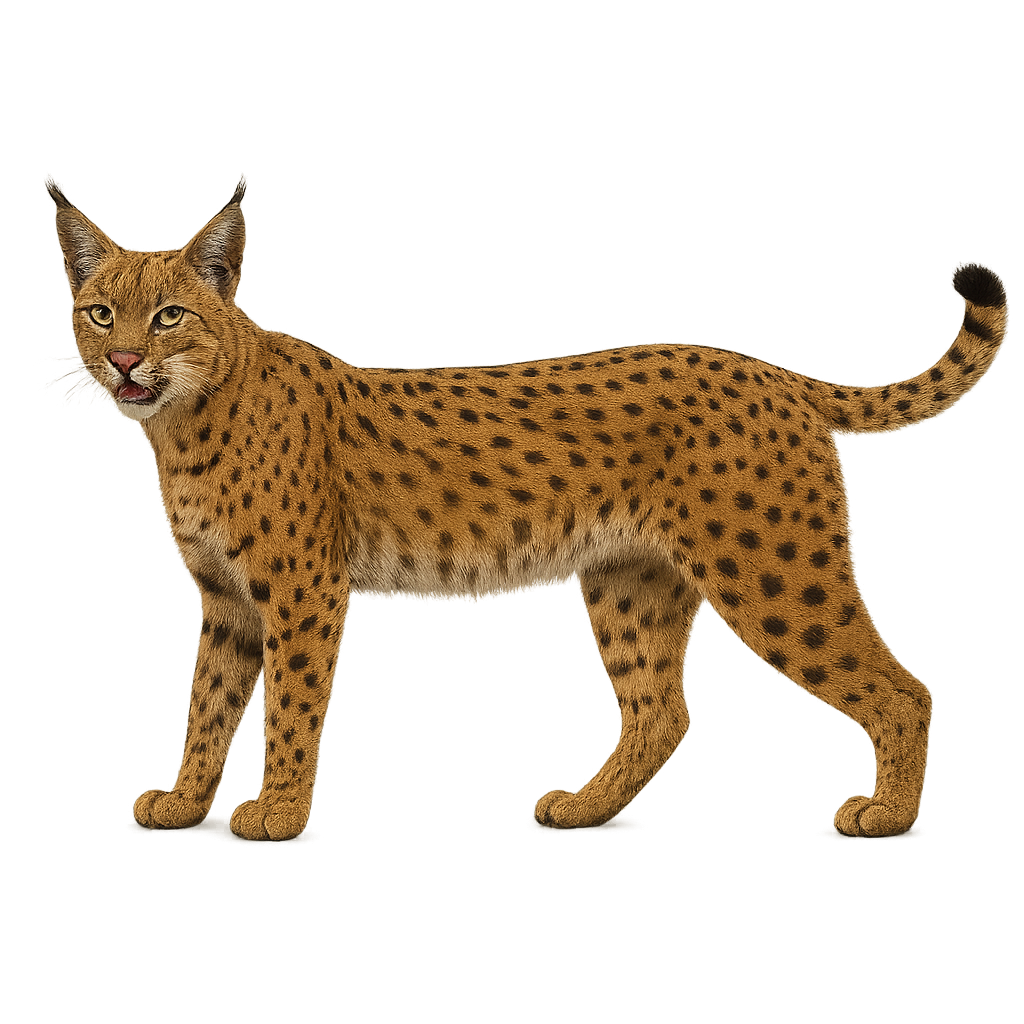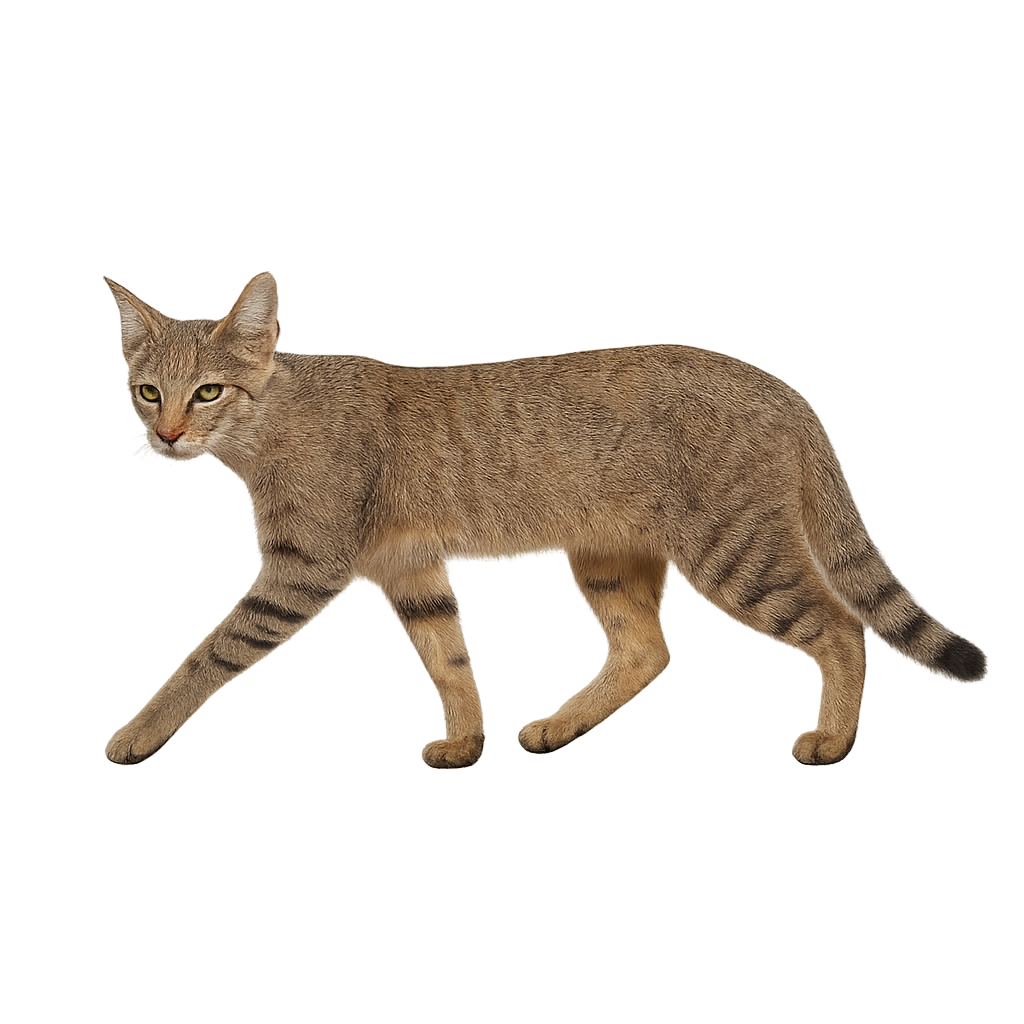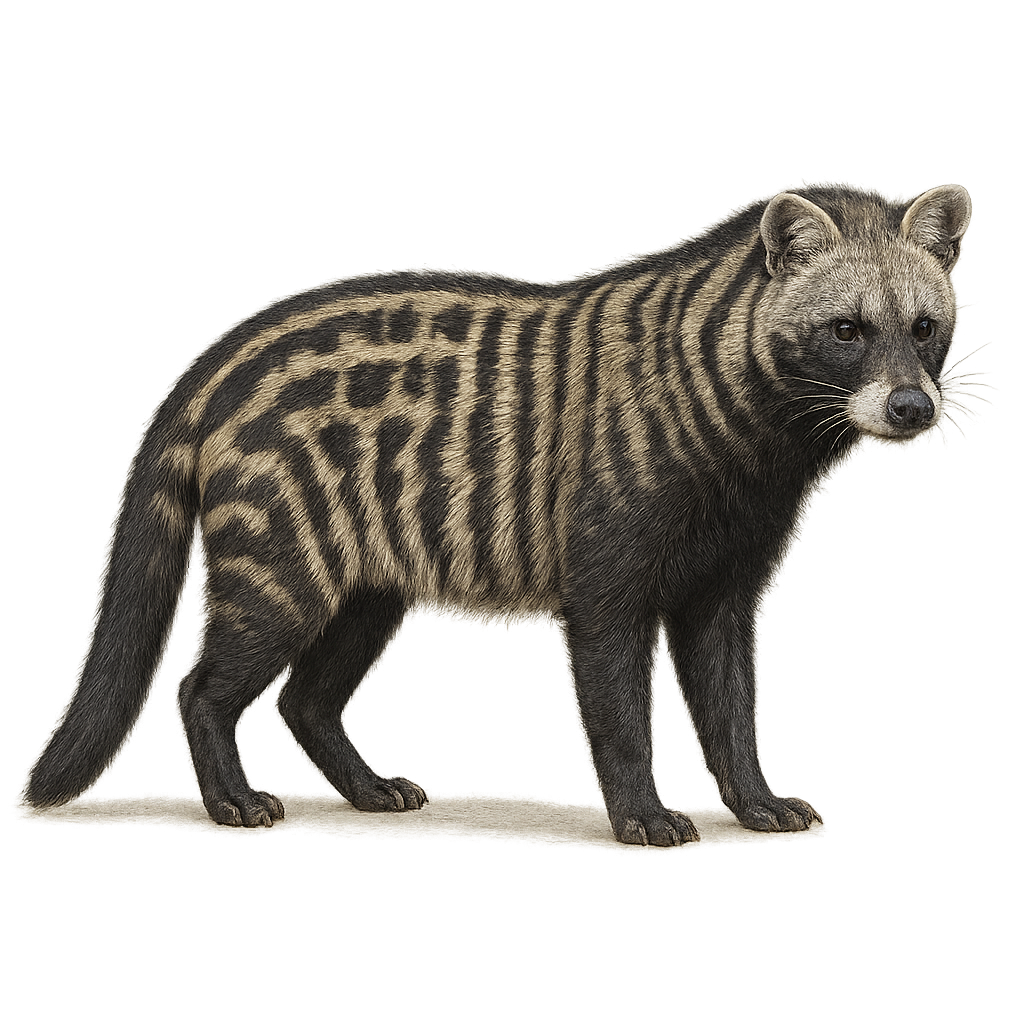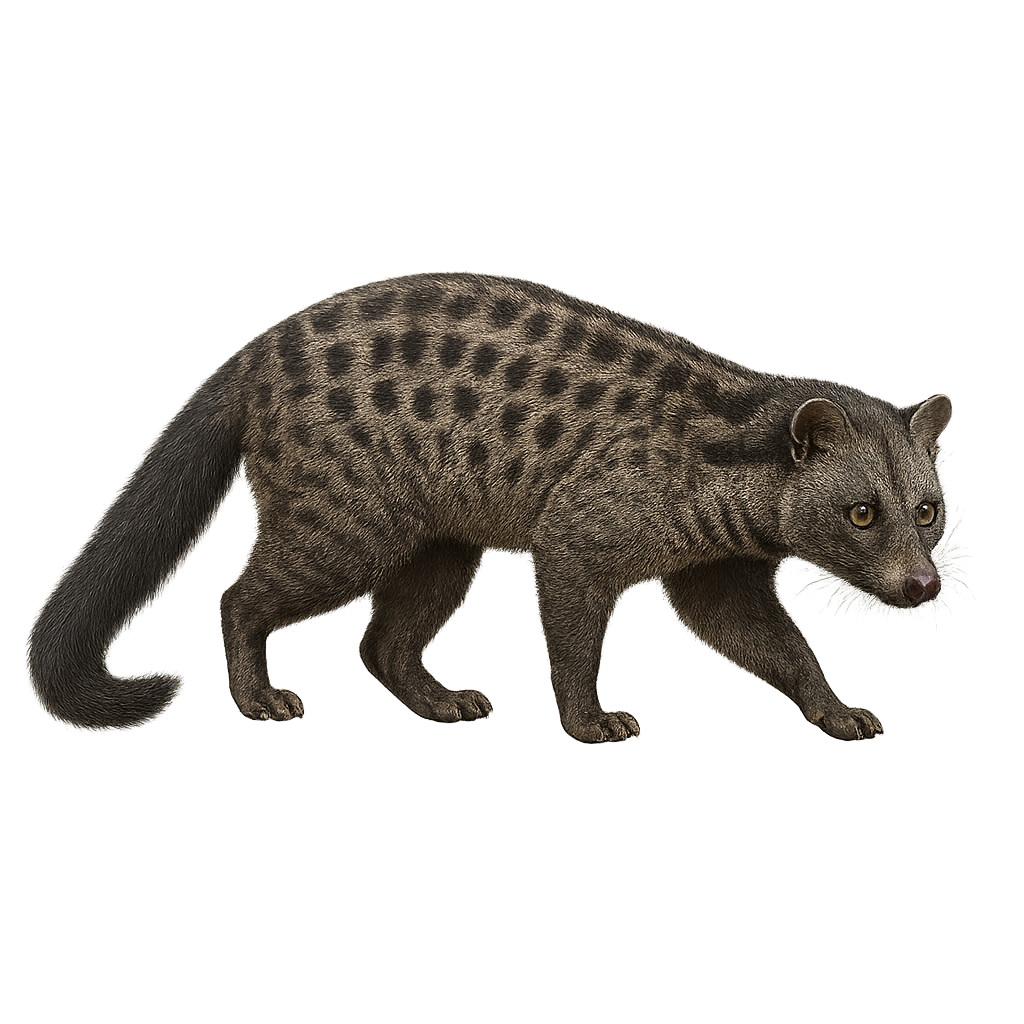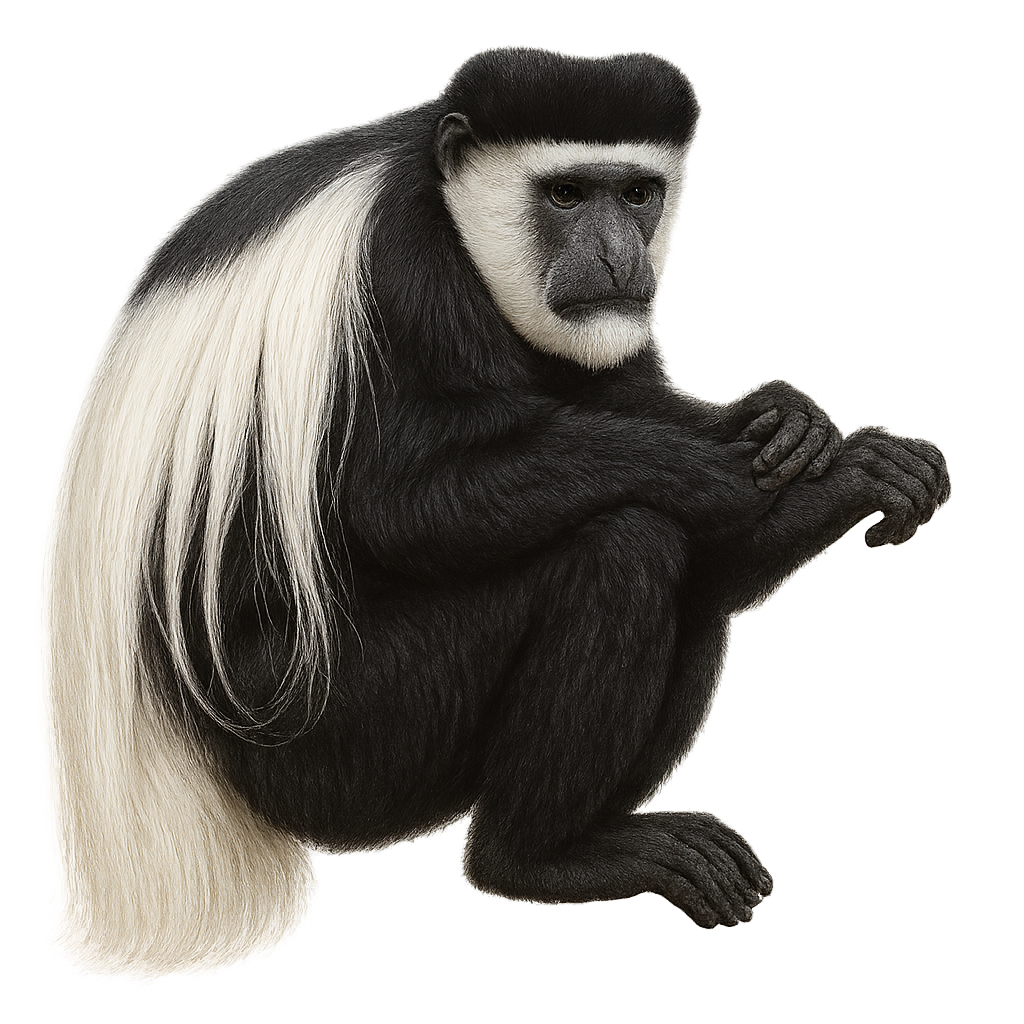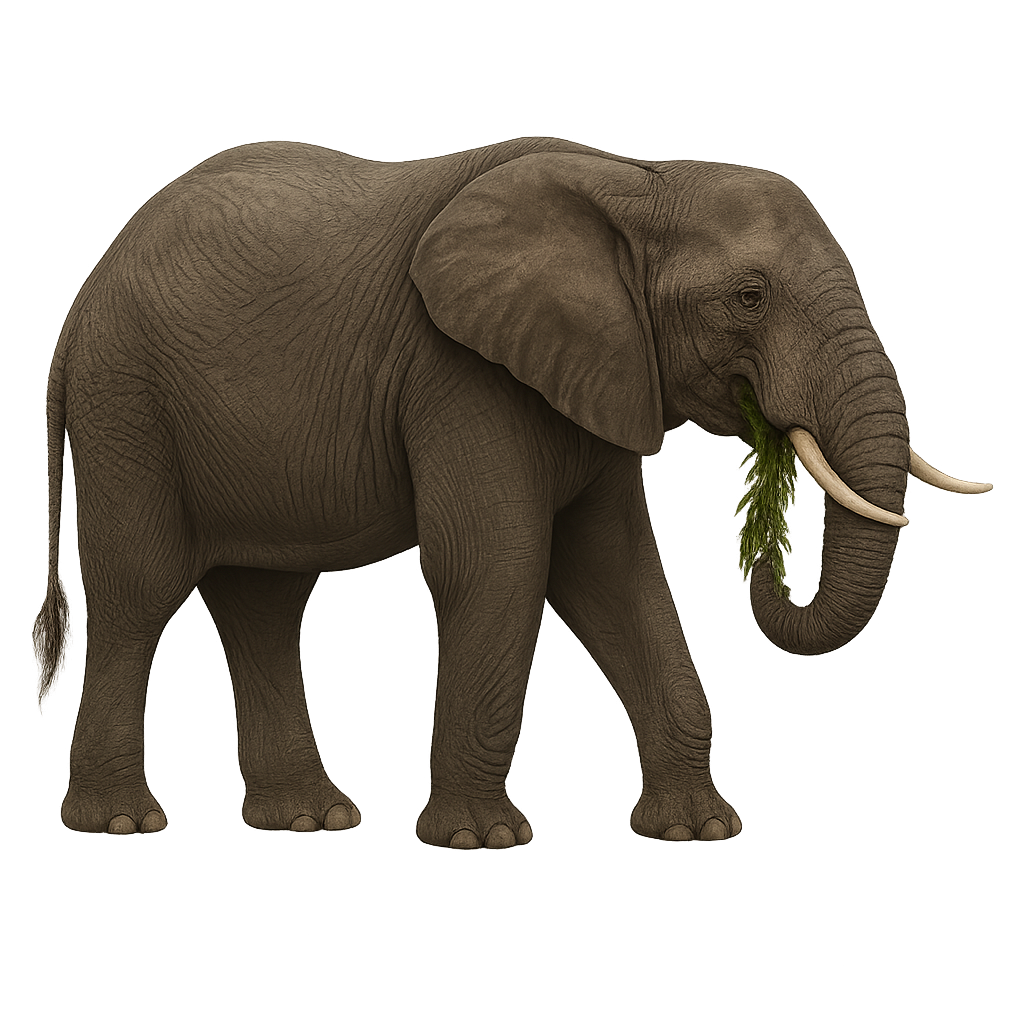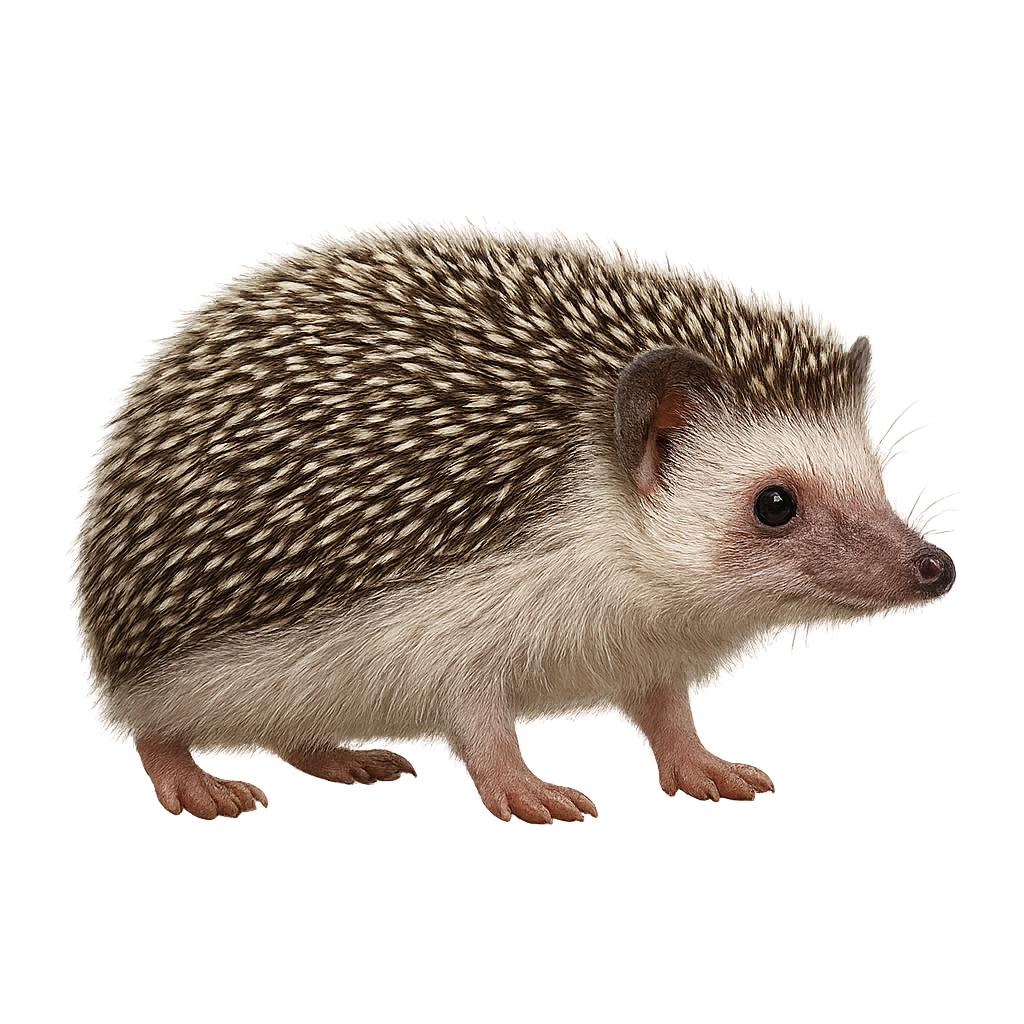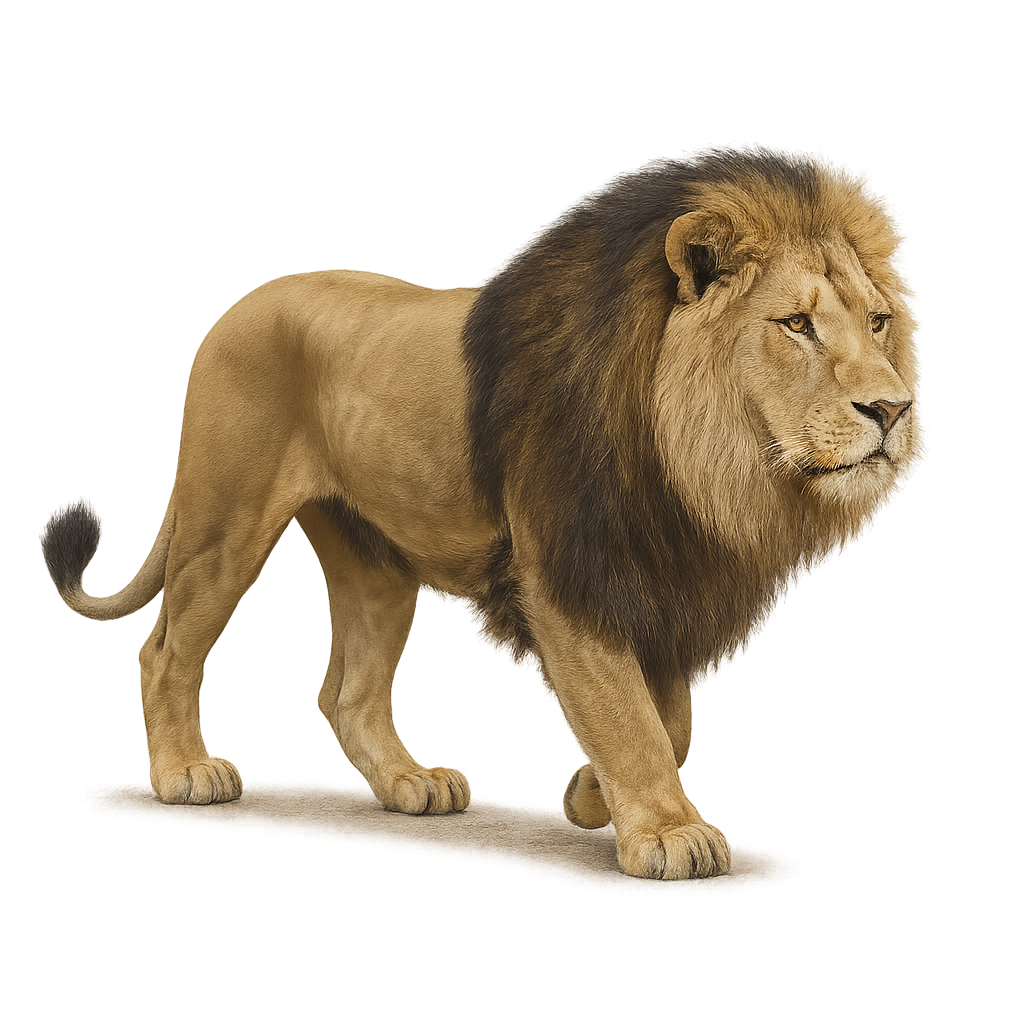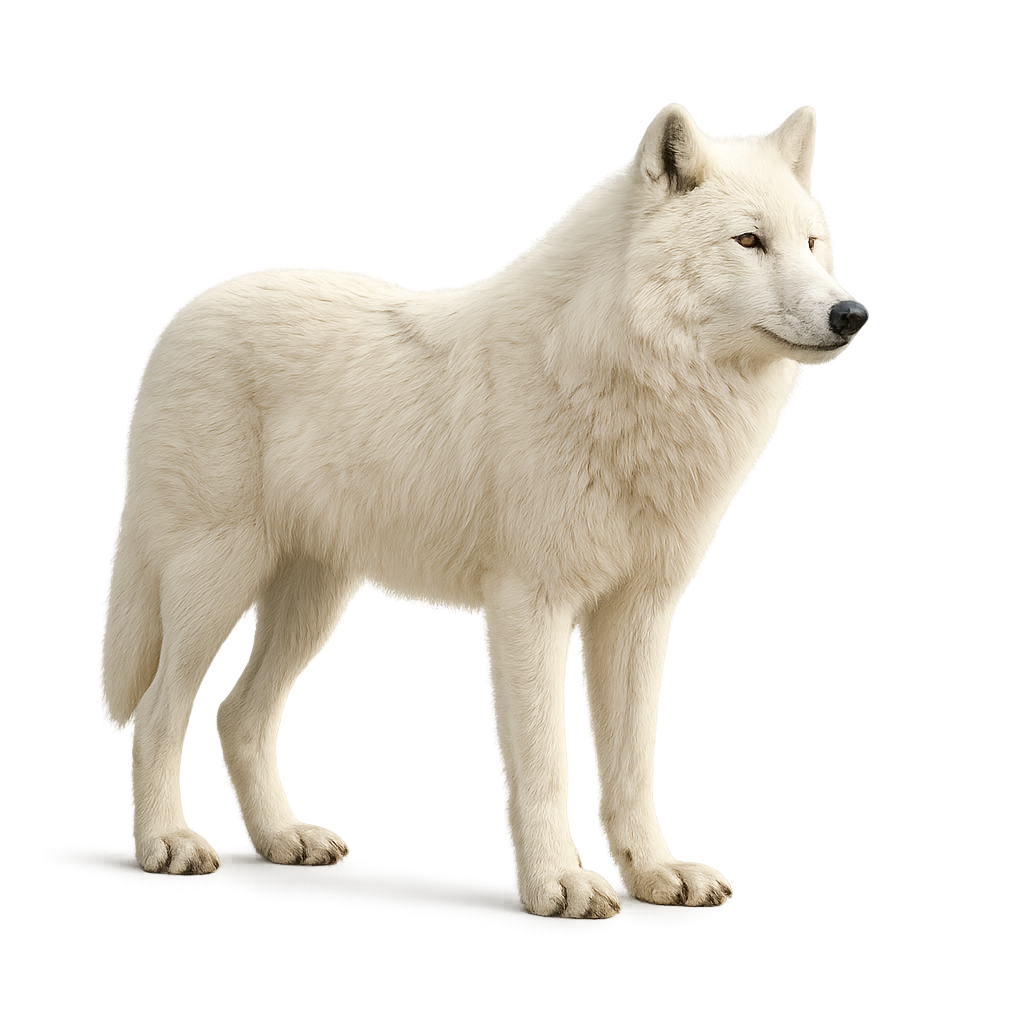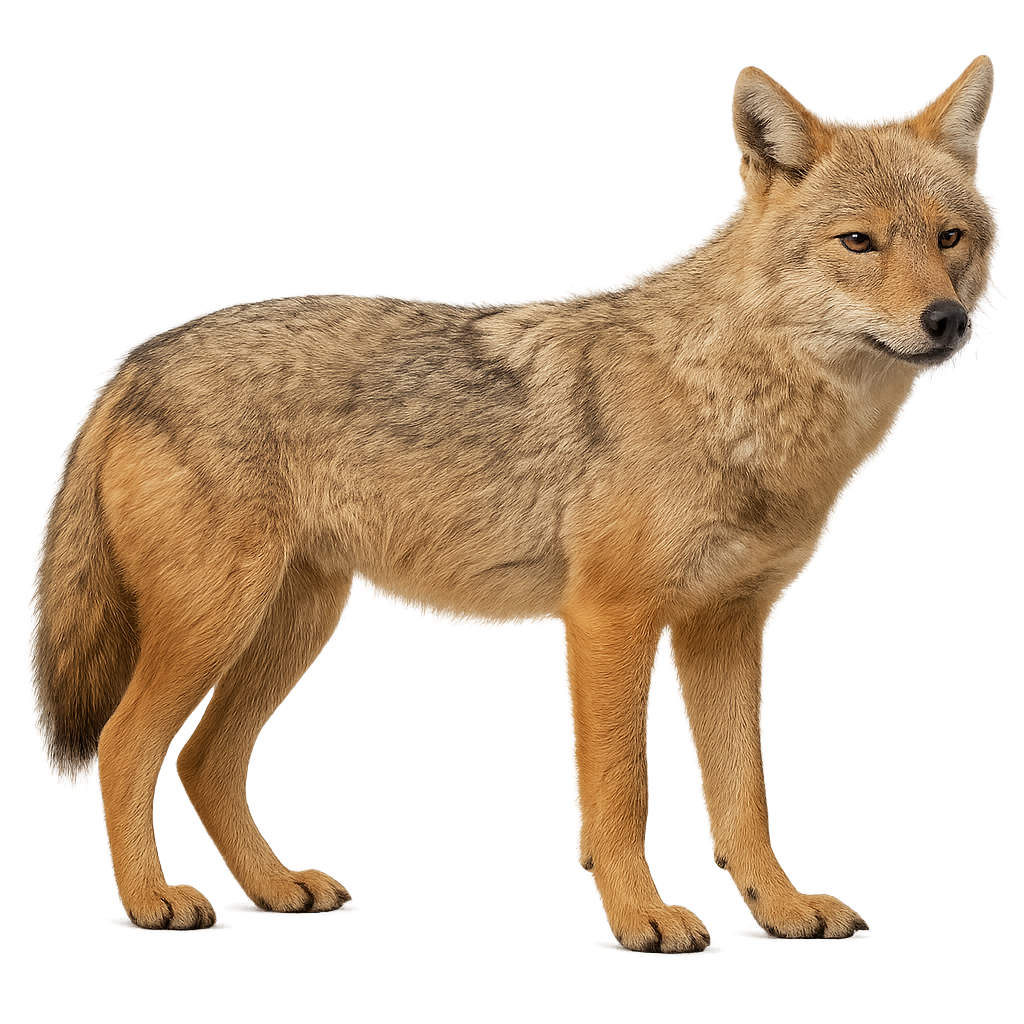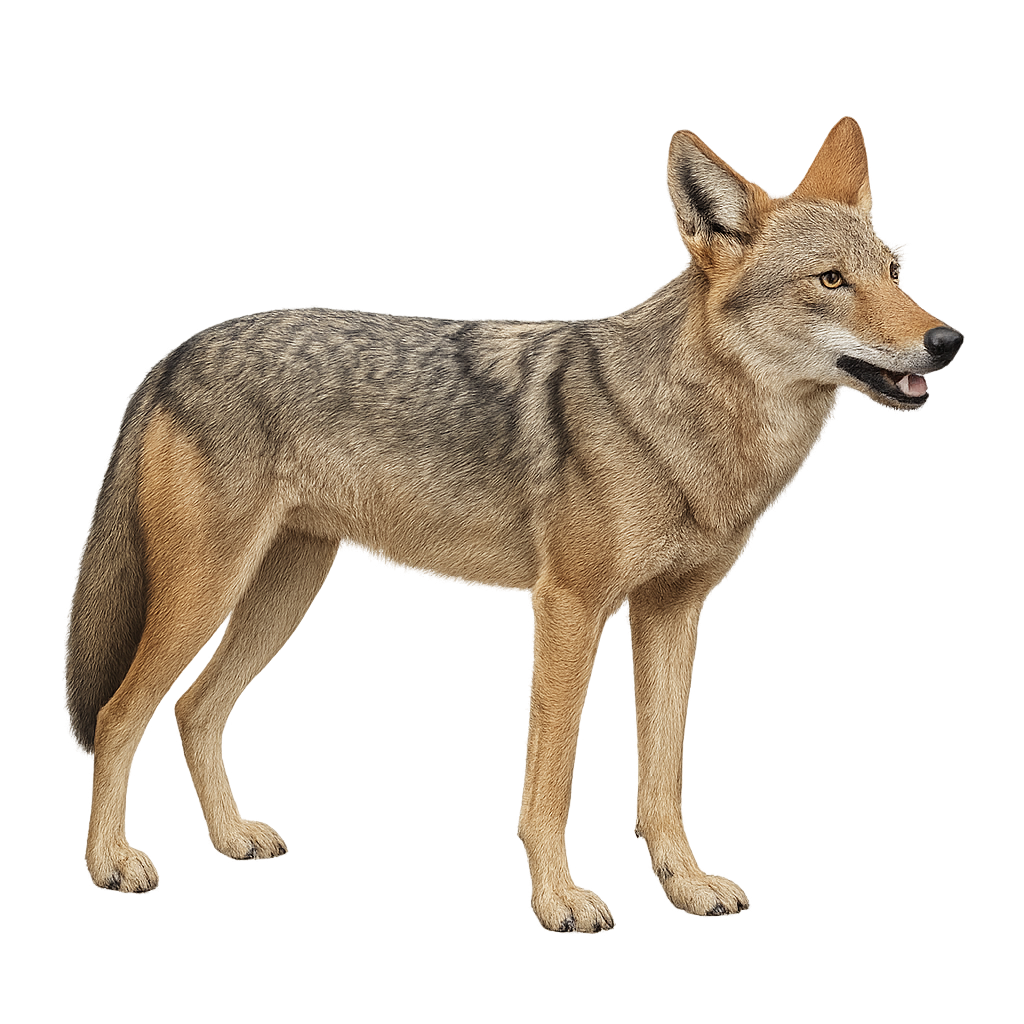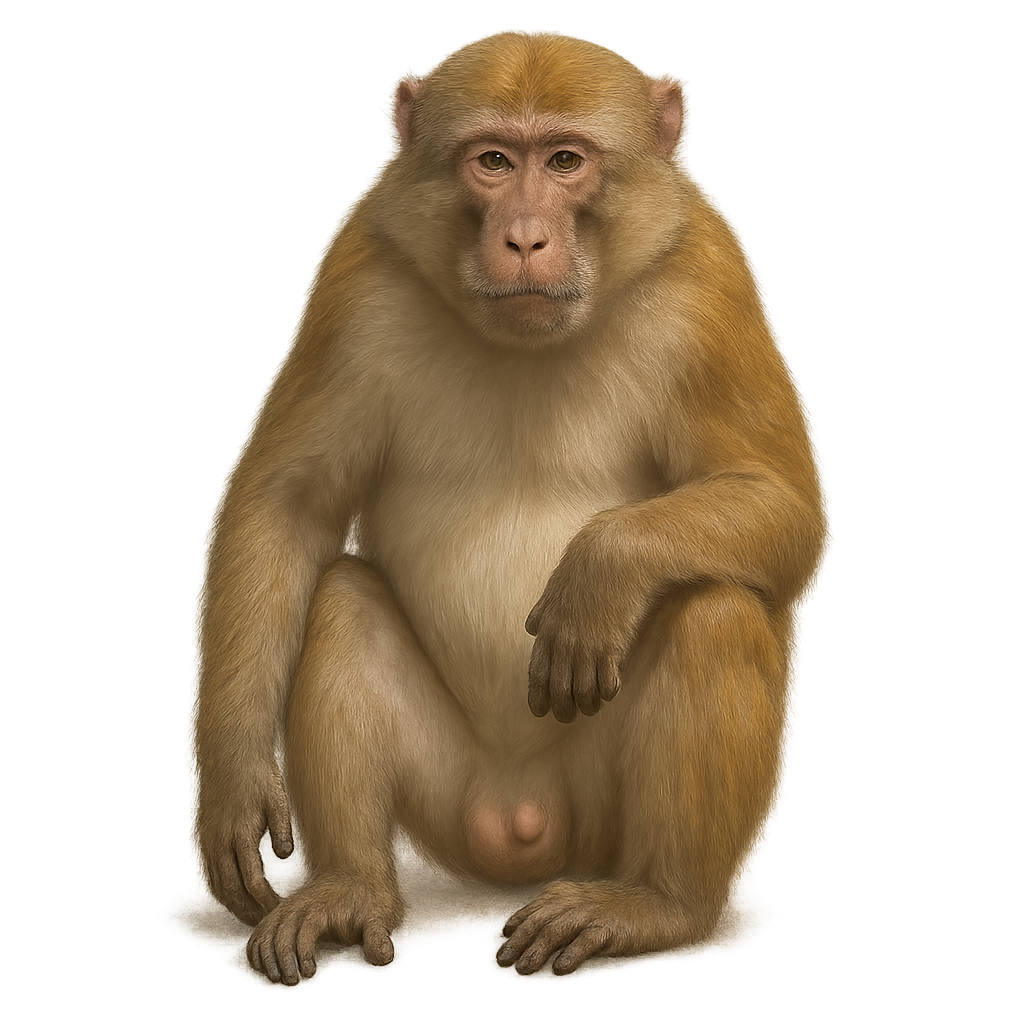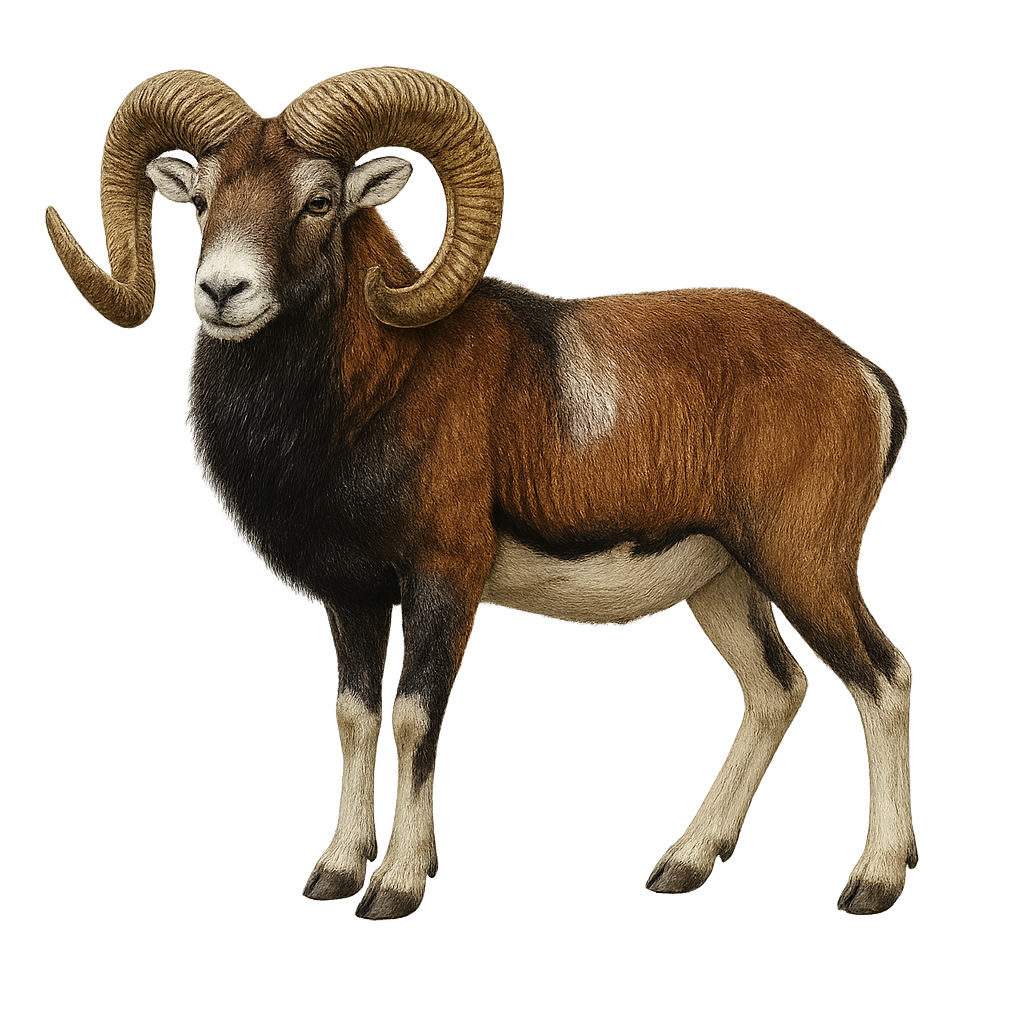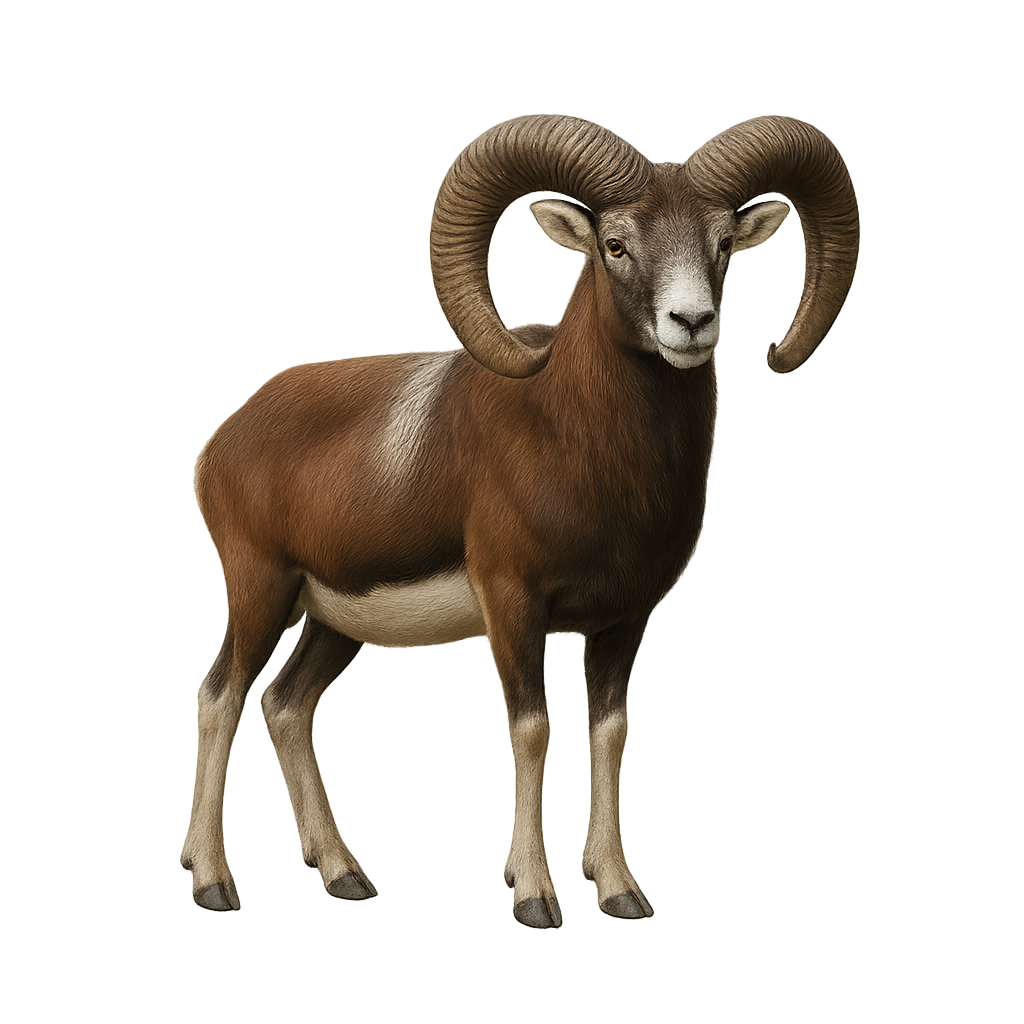The Addax, or white antelope, is a critically endangered species native to the Sahara Desert. Adapted to harsh desert conditions, it has a light-colored coat that reflects sunlight and broad hooves for walking on sand. Addaxes live in small herds and primarily feed on grasses and leaves. They can survive long periods without water. Unfortunately, overhunting and habitat loss have drastically reduced their numbers. Conservation efforts are underway to protect this iconic desert species.
The African Wild Ass, or Equus africanus, is a species of equid native to the arid and semi-arid regions of East and Northeast Africa. It is the wild ancestor of the domestic donkey. This mammal is well adapted to its harsh environment, capable of surviving with minimal water and food. It has a light grey coat with black stripes on its legs, reminiscent of a zebra. Its long, mobile ears allow it to detect predators from a distance. The African Wild Ass lives in small family groups and primarily feeds on grasses and shrubs. Unfortunately, it is critically endangered due to hunting and habitat loss.
The Argali is the largest wild sheep in the world, known for its imposing size and majestic spiral horns. It primarily inhabits the mountains of Central Asia, where it frequents the arid and semi-arid regions of steppes and high plateaus. This large ungulate is perfectly adapted to mountainous environments, moving nimbly on steep terrain at high altitudes. The Argali is a herbivore, feeding on grasses and woody plants.
The Argali is also a symbol of strength and resilience, but it is threatened by habitat loss and overhunting. Conservation efforts are underway to protect this iconic species and preserve its natural habitat.
Aye-aye
Daubentonia madagascariensis
The Aye-aye is a nocturnal lemur endemic to Madagascar, known for its strange appearance, notably its extremely long and thin middle finger which it uses to extract insects and larvae from tree trunks. It is a shy and secretive animal, primarily living in the tropical forests of the island. Due to its unique feeding method, it is sometimes viewed as an omen of misfortune by local populations, though its ecological role in maintaining forest balance is crucial. The Aye-aye is listed as vulnerable due to deforestation and cultural beliefs surrounding it.
The American Bison is one of the largest land mammals in North America, recognizable by its massive head, thick fur, particularly on its back. Once widespread, it nearly went extinct in the 19th century due to overhunting and habitat loss. Today, thanks to conservation efforts, the population of American Bison is growing, though the species remains protected in many areas.
The American Bison lives in herds, primarily in grasslands and plains. Herbivorous, it feeds on grasses, woody plants, and some vegetation. As it moves, it creates powerful tracks in the plains. This social mammal is also known for its territorial behavior, with males fighting for dominance within the group.
The Asian badger, or Meles leucurus, is a medium-sized mammal belonging to the Mustelidae family. It is distinguished by its thick fur and characteristic coloration, with a white stripe on the throat and belly. This badger is primarily nocturnal and inhabits forests, grasslands, and steppes of Central and East Asia. It digs complex burrows where it spends the day and raises its young. Omnivorous, it feeds on small animals, insects, fruits, and roots. Although generally solitary, it can sometimes be seen in small family groups. Its adaptability to various habitats and suspicious behavior make it difficult to observe in the wild.
The American Badger is a medium-sized carnivore, easily recognizable by the distinctive white stripes on its head and its sturdy, stocky body. It primarily inhabits prairies and semi-arid areas in North America, where it digs complex burrows for shelter and raising its young. The American Badger is mainly insectivorous, feeding on worms, insects, and occasionally small mammals and reptiles. Its powerful claws allow it to dig quickly and efficiently into the ground.
The American Badger is a solitary animal, often active at dusk and during the night. While not immediately endangered, it can be affected by habitat loss and illegal hunting in some regions.
The Alpine Ibex is a large herbivorous mammal, easily recognized by its long, curved horns and light brown or grayish coat. It primarily inhabits the rugged mountains of the Alps, southern Europe, and some mountainous regions of the Middle East. The Alpine Ibex feeds on alpine vegetation, grasses, and woody plants, and it is particularly adapted to life at high altitudes due to its great agility on rocky terrain and its thick coat.
This animal is social and lives in family groups, although adult males, called "ibex", form separate groups. After nearly disappearing in the early 20th century due to overhunting, conservation programs have helped stabilize its population. However, it remains vulnerable to habitat loss and human disturbances.
The Alpine Chamois is an elegant and agile ungulate, well adapted to the mountainous environments of the Alps, Pyrenees, and other mountain regions of Europe. It is distinguished by its reddish-brown coat in the summer, which becomes more gray and thicker in the winter, helping it endure the cold temperatures. The Alpine Chamois has small, curved horns, present in both males and females, but larger in adult males.
This ruminant primarily inhabits rocky slopes, mountain forests, and alpine meadows, where it feeds mainly on herbaceous vegetation, mosses, and lichens. The Alpine Chamois is an excellent climber, able to move with agility over steep and rocky terrain. It is usually solitary or lives in small family groups, but may also gather in larger herds during the winter. Although its population is stable in many areas, the Alpine Chamois remains vulnerable to hunting and human disturbances in its mountainous habitats.
The African Golden Cat is a rare and mysterious small feline, characterized by its silky golden coat and pointed ears adorned with tufts of black hair. This medium-sized cat primarily inhabits the forests and savannas of West Africa, where it preys mainly on birds, small mammals, and reptiles. Its golden coat, which gives it its name, is perfect for camouflaging in tall grasses and foliage.
The African Golden Cat is a discreet and solitary hunter, primarily active at dawn and dusk. Although it is rare and difficult to observe due to its nocturnal habits, it plays an important role in regulating prey populations. The species is threatened by habitat loss and poaching, although conservation efforts are in place to protect this elusive feline.
The African Wildcat is a small, discreet, and nocturnal feline, primarily found in desert regions, savannas, and open forests of North and Sub-Saharan Africa. It is often compared to the domestic cat but has a more uniform coat, typically sandy or gray-brown, with light markings on the head and paws. Its eyes are large, adapted for nocturnal vision, and its ears are pointed, enhancing its wild appearance.
This cat is a solitary hunter, feeding mainly on small mammals, birds, and insects. Although shyer than its domestic cousin, it plays an essential role in regulating prey populations in its habitat. It is also known as the ancestor of the domestic cat, which was domesticated from this species around 10,000 years ago. While the African Wildcat is still relatively widespread, it is threatened by habitat loss and human conflict.
The African civet, Civettictis civetta, is a medium-sized carnivorous mammal known for its spotted coat and distinctive black band across its eyes. Native to sub-Saharan Africa, it primarily inhabits savannas, forests, and woodlands. It is mainly nocturnal, feeding on a variety of foods, including fruits, insects, and small animals. The African civet is also known for producing a musky secretion used in the perfume industry. Although generally solitary, it can sometimes be seen in small groups. Its adaptability to various habitats and diverse diet make it a resilient species, though habitat loss and hunting can pose threats.
The African palm civet is a small feliform mammal, 43–71 cm long and weighing 1.4–4.5 kg, with grey to dark brown fur spotted with dark markings. It is native to sub-Saharan Africa, inhabiting moist forests where it feeds on fruits, aquatic invertebrates and small vertebrates at night. Crepuscular and nocturnal, it sleeps in trees during the day and forages at dusk and night.
The Angolan colobus, or Colobus angolensis, is an arboreal primate known for its striking black and white fur. This monkey is particularly recognizable by the long white fringes adorning its shoulders and tail. It primarily inhabits the tropical forests of Central and East Africa, spending most of its time in the canopy. The Angolan colobus is a strict herbivore, feeding mainly on leaves, fruits, and flowers. It lives in social groups of up to 15 individuals, led by a dominant male. Although its habitat is threatened by deforestation, it remains relatively widespread in some areas.
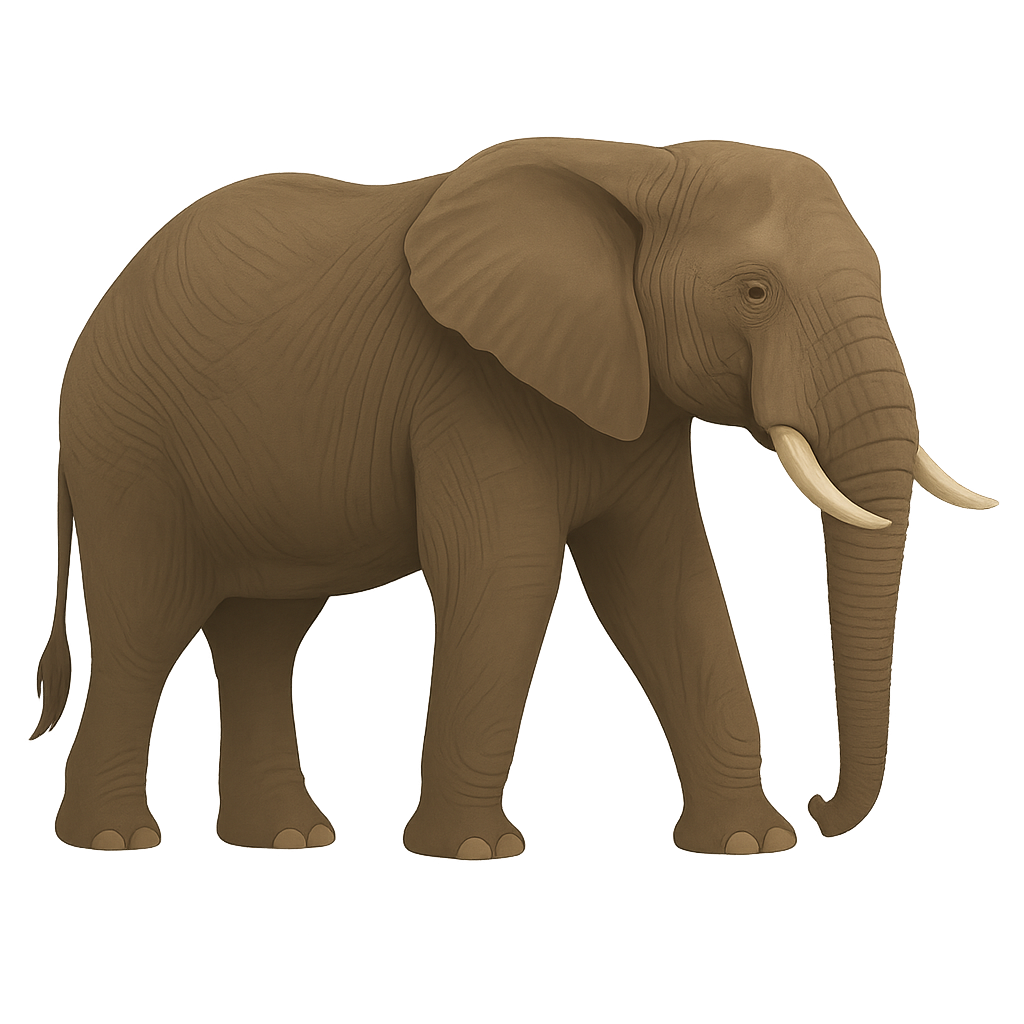
The African Savannah Elephant is the largest land mammal, and the largest of all terrestrial animals. It can stand up to 4 meters tall at the withers and weigh between 4,000 and 7,500 kg. Its coat is gray, with rough skin often covered in dust or mud to protect it from the sun and parasites. The African Savannah Elephant is easily recognizable by its large ears, shaped like the map of Africa, which help regulate its body temperature. This elephant is primarily herbivorous, feeding on leaves, bark, fruits, and plants. It inhabits savannas, grasslands, and open forests across sub-Saharan Africa. The African Savannah Elephant is a social animal, living in family groups led by an older female. It plays a crucial role in its ecosystem by creating openings in vegetation and dispersing seeds. However, the species is threatened by habitat loss, poaching for its valuable tusks, and conflicts with human communities. The African Savannah Elephant is currently listed as vulnerable by the International Union for Conservation of Nature (IUCN).

The Asian Elephant is a large land mammal, known for its imposing size and large rounded ears. It typically stands between 2 and 3.5 meters at the withers and weighs between 2,000 and 5,000 kg. Its coat is generally grayish, although some individuals may have a more brownish tint. The Asian Elephant differs from the African Elephant in its smaller size, narrower ears, and its trunk, which has a single "finger" at the tip. This elephant primarily inhabits tropical forests, savannas, and wetland areas in South and Southeast Asia, including India, Thailand, Sri Lanka, and Cambodia. It is herbivorous, feeding on leaves, bark, fruits, and grasses. The Asian Elephant has often been associated with human communities due to its historical role in labor, transport, and religious ceremonies. However, the species is threatened by habitat loss due to agriculture, poaching for its valuable tusks, and conflicts with human populations. It is listed as endangered by the International Union for Conservation of Nature (IUCN).
The Forest Elephant is a large land mammal, characterized by its smaller size compared to the Asian Elephant and the African Savannah Elephant, standing around 2 to 3 meters at the withers and weighing between 2,000 and 5,000 kg. Its coat is gray, but its skin is often rougher than other elephants, and its ears are smaller, adapted to its forest habitat. The Forest Elephant primarily inhabits the dense forests of Central and West Africa, where it feeds on a wide variety of vegetation, including leaves, bark, fruits, and roots. Unlike the Savannah Elephant, it is more discreet and less social, though it may form small family groups. This elephant plays a key role in its ecosystem, contributing to seed dispersal and forest regeneration. However, the species is threatened by deforestation, poaching for its valuable tusks, and conflicts with human communities. It is currently listed as vulnerable by the International Union for Conservation of Nature (IUCN).
The Asiatic cheetah, or Iranian cheetah, is a rare subspecies of cheetah primarily found in Iran. It is distinguished by its tawny coat with black spots and its slender, speed-adapted body. This feline is a symbol of Iranian wildlife but is critically endangered due to habitat loss, hunting, and a decrease in natural prey. Conservation efforts focus on habitat protection and raising awareness among local communities. The Asiatic cheetah is a diurnal hunter, using its incredible speed to catch prey such as gazelles and hares.
The African Pygmy Hedgehog, scientifically known as Atelerix albiventris, is a small insectivorous mammal native to sub-Saharan Africa. It is easily identifiable by its spiny back and white belly. This hedgehog measures about 15 to 25 cm in length and weighs between 300 and 600 grams. Primarily nocturnal, it feeds on insects, small invertebrates, and occasionally fruits. In captivity, it is often kept as a pet due to its compact size and generally docile nature. However, it requires specific care, including a suitable habitat and balanced diet to remain healthy.
The Asiatic lion, or Panthera leo persica, is a subspecies of lion found primarily in the Gir Forest of India. Smaller than its African counterpart, it is distinguished by a less developed mane and a distinctive belly fold. Asiatic lions live in groups called prides, consisting of a few females and their cubs, while adult males are often solitary or in small groups. They primarily hunt ungulates such as sambar and chital. Although their population has increased due to conservation efforts, they remain endangered due to habitat loss and poaching.
The Arctic Wolf is a subspecies of the gray wolf, primarily found in the cold and snowy regions of the Arctic, particularly in northern Canada, Alaska, and Greenland. It measures about 1.5 to 2 meters in length, including its tail, and weighs between 30 and 50 kg, with males generally being larger than females. Its coat is thick and pure white, allowing it to blend perfectly into the snowy landscapes. This wolf has evolved to adapt to the extreme conditions of its environment, with wide paws that allow it to walk in deep snow, and dense fur that protects it from the cold. The Arctic Wolf lives in family groups, typically consisting of 5 to 10 individuals, who hunt together for prey such as caribou, birds, and other mammals. Although this subspecies is adapted to its environment, it is vulnerable to climate change, which affects the distribution of its prey and natural habitat. The Arctic Wolf is also threatened by hunting and habitat loss due to human activity.
The Canis lupus pambasileus, commonly known as the Alaskan wolf, is a subspecies of the gray wolf primarily inhabiting the wild regions of Alaska and the Yukon. Known for its large size and thick fur, this wolf is well adapted to the harsh climatic conditions of its habitat. It lives in structured packs, allowing it to efficiently hunt large prey such as caribou and moose. The Alaskan wolf plays a crucial role in the ecosystem by regulating prey populations. Although generally wary of humans, it can be observed from a distance in national parks. Its conservation is vital for maintaining the ecological balance of its environment.
The Golden Wolf is a medium-sized canid native to the Middle East and certain regions of East Africa. It measures about 1.2 to 1.5 meters in length, including its tail, and weighs between 11 and 20 kg. Its coat is generally golden yellow or light brown, with black markings on its back and legs, and lighter shades on its belly. It has long, pointed ears and a narrow, elongated head. The Golden Wolf is primarily carnivorous, feeding on small mammals, birds, reptiles, and sometimes fruits. It lives in family groups or small packs and often hunts cooperatively with other members of the group. The Golden Wolf prefers open areas such as savannas, steppes, and mountains and is particularly adapted to semi-arid environments. Although the species is not immediately endangered, it is threatened by habitat loss, human conflict, and competition with larger carnivores such as jackals and lions.
The Canis lupus lupaster, commonly known as the African golden wolf, is a medium-sized canid primarily inhabiting the northern and eastern regions of Africa. It has a dense, golden coat, often interspersed with gray or silver hues, allowing it to blend into the arid and semi-arid landscapes it frequents. This opportunistic predator feeds on a variety of prey, ranging from small mammals to birds, and does not hesitate to scavenge. Although often solitary, it can form pairs or small packs for hunting. Its adaptable behavior and ability to thrive in diverse environments make it a remarkable survivor.
The African clawless otter is a semi-aquatic mustelid, 60–100 cm long, with dark brown fur and a paler throat. Found across tropical and subtropical sub-Saharan Africa, it inhabits rivers, lakes, swamps, and estuaries. An excellent swimmer, it feeds on fish, crustaceans, and molluscs, diving skillfully to capture its prey.
The African Wild Dog is an exceptional social predator, easily recognized by its unique spotted coat, which ranges in color from yellow-orange to black, with irregular markings. It has large, rounded ears and an expressive face. This carnivore primarily lives in organized packs, which allow it to effectively hunt large mammals such as gazelles and impalas. Their hunting strategy is based on cooperation, speed, and endurance, with long and energetic chases.
The African Wild Dog is also known for its social behavior, with pack members maintaining strong bonds through vocalizations, play, and grooming rituals. Unfortunately, this species is endangered due to habitat loss, illegal hunting, and conflicts with humans. It is a protected species, and efforts are underway to preserve remaining populations in wildlife reserves.
The Assam macaque, or Macaca assamensis, is a medium-sized primate native to the forests of Southeast Asia. It is characterized by its gray-brown fur and pink face, often surrounded by a lighter beard of hair. This monkey lives in complex social groups led by a dominant male. It is primarily arboreal but often descends to the ground to forage. An omnivore, its diet includes fruits, leaves, insects, and small animals. The Assam macaque plays a crucial role in seed dispersal, thus contributing to the health of its ecosystem. Unfortunately, it is threatened by deforestation and hunting, leading to a decline in its populations.
The Alpine Marmot is a large rodent primarily found in the mountainous regions of Europe, especially in the Alps, the Pyrenees, and the mountains of Italy. It measures about 40 to 60 cm in length, with a tail of 10 to 15 cm, and weighs between 3 and 7 kg, with females generally being a little smaller than males. Its coat is thick and typically brown-gray, with a lighter belly, allowing it to blend into its rocky and grassy environment. The Alpine Marmot lives in burrows dug into the ground, where it takes refuge to sleep, escape predators, and hibernate during the winter, a period when it enters a state of torpor for several months. During the summer season, it primarily feeds on grasses, roots, flowers, and berries. The Alpine Marmot is a social animal, typically living in family groups or colonies. While its population remains relatively stable, it is threatened by climate change and human development of its natural habitat.
The Armenian Mouflon, Ovis orientalis gmelini, is a medium-sized mammal belonging to the Bovidae family. It is characterized by its spiral horns, more developed in males than in females. Its coat is generally brown with lighter shades on the belly and legs. This mouflon is mainly found in the mountainous regions of Armenia and Iran, where it adapts to rugged terrains and variable climatic conditions. It lives in herds, often separated by sex, and primarily feeds on grasses, herbs, and shrubs. The Armenian Mouflon plays an important ecological role as an herbivore, contributing to the regulation of vegetation in its natural habitat.
The Asian mouflon, or Ovis orientalis, is a mammal from the Bovidae family, native to the mountains of Western Asia. It is recognizable by its large, spiraled horns, especially prominent in males. Its coat ranges from brown to gray, with lighter shades on the belly and legs. Mouflons live in herds, often segregated by sex, and navigate rugged, rocky terrains. They are herbivores, primarily feeding on grasses and low-growing plants. Their social behavior is complex, with established hierarchies within groups. Males compete during the rutting season to assert dominance and gain access to females.


